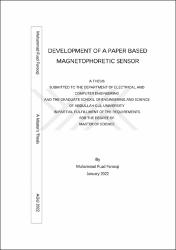| dc.contributor.author | FAROOQI, MUHAMMAD FUAD | |
| dc.date.accessioned | 2022-06-20T10:01:40Z | |
| dc.date.available | 2022-06-20T10:01:40Z | |
| dc.date.issued | 2022 | en_US |
| dc.date.submitted | 2022-01 | |
| dc.identifier.citation | A THESIS SUBMITTED TO THE DEPARTMENT OF ELECTRICAL AND COMPUTER ENGINEERING AND THE GRADUATE SCHOOL OF ENGINEERING AND SCIENCE OF ABDULLAH GUL UNIVERSITY IN PARTIAL FULFILLMENT OF THE REQUIREMENTS FOR THE DEGREE OF MASTER OF SCIENCE | en_US |
| dc.identifier.uri | https://hdl.handle.net/20.500.12573/1292 | |
| dc.description.abstract | One of the widely used type of biosensors are paper-based lateral flow systems. They are used to detect a wide variety of biomolecules like microorganisms, proteins, chemicals, oligonucleotides among many others. In this research, a setup was created using dual magnet sets in which the flow of cell sample on two kinds of different sample paper was explored. There were two factors which affected the movement of the sample the most, the magnetic field and the wetting. Images were obtained using a cell phone along and/or a bright field optical microscope and then analyzed using image processing. Images were also taken using scanning electron microscope. The effects of the wetting and the magnetic field were tested and studied. It was found that at least 90% of the cells were able to reach the edge of the paper. Although the cells were not able to maintain their shape on the paper due to the unideal conditions of the paper for cells but still this kind of paper-based lateral flow assay setup can be used for cells to see their behavior when they were labelled and exposed to a magnetic field. This research shows support that this technique can be used for separating cells as well as detecting different cells. | en_US |
| dc.description.abstract | Yaygın olarak kullanılan biyosensör tiplerinden biri kağıt tabanlı yanal akış sistemleridir. Bu sistemler mikroorganizmalar, proteinler, kimyasallar, oligonükleotitler ve diğerleri gibi çok çeşitli biyomolekülleri tespit etmek için kullanılırlar. Bu araştırmada, hücre numunesinin akışının iki çeşit farklı numune kağıdı üzerinde araştırıldığı ikili mıknatıs setleri kullanılarak bir düzenek oluşturulmuştur. Numunenin hareketini en çok etkileyen iki faktör manyetik alan ve ıslanmadır. Bu çalışmada ki görüntüler bir cep telefonu ve/veya parlak alan optik mikroskobu kullanılarak elde edilmiş ve ardından görüntü işleme kullanılarak analiz edilmiştir. Ayrıca bazı örnekler taramalı elektron mikroskobu kullanılarak görüntülenmiştir. Bu çalışmada ıslanmanın ve manyetik alanın etkileri test edilmiş ve incelenmiştir. Hücrelerin en az %90'ının kağıdın kenarına ulaşabildiği gözlenmiştir. Kağıdın hücreler için ideal olmayan koşulları nedeniyle hücreler kağıt üzerinde şekillerini uzun süre koruyamasa da, bu tür kağıt tabanlı yanal akış sistemleri önemli avantajları nedeniyle, hücresel uyuglamlar için potansiyel barındırmaktadır ve hücreleri algılamak için kullanılabilir. Bu çalışma, manyetik alanın ve kağıt temelli platformların hücreleri ayırmak ve farklı hücreleri tespit etmek için kullanılabileceğini göstermektedir. | en_US |
| dc.description.tableofcontents | 1. INTRODUCTION .................................................................................................... 1
1.1 BIOSENSORS ............................................................................................................. 1
1.2 MAGNETOPHORESIS ................................................................................................. 2
1.3 LATERAL FLOW BIOSENSORS ................................................................................... 3
1.4 MICRO/NANO MAGNETIC PARTICLES ...................................................................... 4
1.5 ANTIBODIES ............................................................................................................. 6
1.5 FORCES .................................................................................................................... 7
1.6 FLUID FLOW ON PAPER ............................................................................................ 8
2. MATERIALS AND METHODS ........................................................................... 10
2.1 MAGNETIC PLATFORM ........................................................................................... 10
2.2 MAGNETIC FORCE .................................................................................................. 11
2.3 WETTING ............................................................................................................... 12
2.4 PAPER-BASED MAGNETOPHORESIS ........................................................................ 12
2.4.1 Cell Preparation ............................................................................................ 12
2.4.2 Paper Preparation ......................................................................................... 14
2.4.3 Paper-Based Experiment ............................................................................... 15
2.4.5 BSA Wetting ................................................................................................... 16
2.4.7 Imaging .......................................................................................................... 17
2.4.8 Magnetic Field Cell Experiments .................................................................. 17
2.5 IMAGE PROCESSING ............................................................................................... 17
2.6 COMSOL SIMULATION ......................................................................................... 19
3. RESULTS ................................................................................................................ 24
3.1 MAGNETIC FORCE AND WETTING .......................................................................... 24
3.2 PAPER-BASED MAGNETOPHORESIS ........................................................................ 31
4. DISCUSSION AND CONCLUSION .................................................................... 38
4.1 DISCUSSION ........................................................................................................... 38
4.2 SOCIETAL IMPACT AND CONTRIBUTION TO GLOBAL SUSTAINABILITY .................. 40
4.3 CONCLUSION AND FUTURE PROSPECTS .................................................................. 40 | en_US |
| dc.language.iso | eng | en_US |
| dc.publisher | Abdullah Gül Üniversitesi Fen Bilimleri Enstitüsü | en_US |
| dc.rights | info:eu-repo/semantics/openAccess | en_US |
| dc.subject | Paper-based biosensor | en_US |
| dc.subject | cell separation | en_US |
| dc.subject | magnetic force | en_US |
| dc.subject | fluid-flow | en_US |
| dc.subject | immunomagnetic particles | en_US |
| dc.title | DEVELOPMENT OF A PAPER BASED MAGNETOPHORETIC SENSOR | en_US |
| dc.type | masterThesis | en_US |
| dc.contributor.department | AGÜ, Fen Bilimleri Enstitüsü, Elektrik ve Bilgisayar Mühendisliği Ana Bilim Dalı | en_US |
| dc.relation.publicationcategory | Tez | en_US |


















